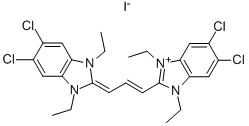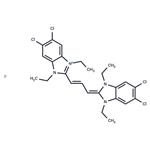Description
JC-
1 is a membrane-
permeable cationic dye that is used to study mitochondrial integrity in the context of cellular apoptosis. It selectively enters mitochondria and changes fluorescence characteristics with alteration in mitochondrial transmembrane potential (ΔΨm). In healthy cells with a high mitochondrial ΔΨm, JC-
1 forms complexes known as J-
aggregates, which fluoresce red/orange and may be detected using FL2 settings by flow cytometry. A drop in ΔΨm, a very early event in apoptosis, results in JC-
1 monomers, which fluoresce green (FL1 settings on flow cytometers). JC-
1 may also be used with fluorescent microscopes or plate readers, using excitation at 520-
570 nm and emission at 570-
610 nm for J-
aggregates and excitation at 485 nm and emission at 535 nm for monomers.
Uses
A dual-emission potential-sensitive probe that can be used to measure mitochondrial membrane potential. JC-1 is a green-fluorescent monomer at low membrane potential. At higher potentials, JC-1 forms red-fluorescent "J-aggregates," which exhibit broad exc
Uses
The cyanine dye JC-1 has been used to determine mitochondrial transmembrane potential.
Definition
ChEBI: 1,1',3,3'-tetraethyl-5,5',6,6'-tetrachloroimidacarbocyanine iodide is a cyanine dye and an organic iodide salt. It has a role as a fluorochrome. It contains a 1,1',3,3'-tetraethyl-5,5',6,6'-tetrachloroimidacarbocyanine.
References
1) Reers et al. (1991), J-aggregate formation of a carbocyanine as a quantitative fluorescent indicator of membrane potential; Biochemistry, 30 4480
2) Smiley et al. (1991), Intracellular heterogeneity in mitochondrial membrane potentials revealed by a J-aggregate-forming lipophilic cation JC-1; Proc. Natl. Acad. Sci. USA, 88 3671
3) Lisa et al. (1995), Mitochondrial membrane potential in single living adult rat cardiac myocytes exposed to anoxia or metabolic inhibition; J. Physiol., 486 1
4) Wolosin et al. (2017), Application of JC1 for non-toxic isolation of cells with MDR transporter activity by flow cytometry; PLoS One, 12(4) e0174905
5) Wang et al. (2017), A novel cytoprotective peptide protects mesenchymal stem cells against mitochondrial dysfunction and apoptosis induced by starvation via Nrf2/Sirt3/FoxO3a pathway; J. Transl. Med., 15 33




